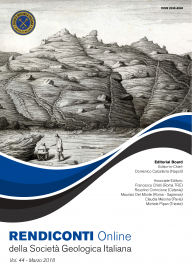
On the first description of tetrapod footprints from Italy: re-analysis of the original specimen after 150 years
Lorenzo Marchetti (1), Fabio Massimo Petti (2,3), Massimo Bernardi (3,4), Paolo Citton (5),
Roberta Rossi (6) & Paolo Schirolli (7)
(1) Urweltmuseum GEOSKOP, Burg Lichtenberg (Pfalz), Thallichtenberg, Germany.
(2) PaleoFactory, Sapienza University of Rome, Italy.
(3) MUSE - Museo delle Scienze di Trento, Trento, Italy.
(4) School of Earth Sciences, University of Bristol, Bristol, UK.
(5) CONICET, Instituto de Investigación en Paleobiología y Geología, Universidad Nacional de Río Negro, Río Negro, Argentina.
(6) ISPRA - Italian National Institute for Environmental Protection and Research, Rome, Italy.
(7) Museo Civico di Scienze Naturali, Brescia, Italy.
Corresponding author e-mail: lorenzo.marchetti85@gmail.com.
Volume: 44/2018
Pages: 112-118
Abstract
In Italy, vertebrate ichnology developed rather recently, especially starting from the 70's of the last century. However, fossil footprints from Italian continental successions were known since the 19th
century. The first scientific note was published by Curioni (1870), after a short report on the same material by Geinitz (1869). Curioni described and drew a small slab with tetrapod tracks from the lower Permian strata of Lombardy (Collio Formation, upper Trompia Valley, Brescian Alps), found by the private collector Don Bruni, Priest of Collio. Subsequent publications always referred to that description, but the original specimen was never restudied, due also to the absence of information about the repository (Curioni, 1870). The original specimen belongs to the prestigious Curioni collection (donated by Curioni to the Regio Ufficio Geologico in 1877) and is nowadays located in the Italian National Institute for Environmental Protection and Research (ISPRA) in Rome. Grounding on the most advanced ichnological methods, in this paper we provide a redescription of the specimen. The study ultimately confirmed the attribution of the three main tracks (a pes-manus couple and a single manual imprint) to the ichnogenus Amphisauropus, tracks probably produced by seymouriamorph reptiliomorphs. Smaller footprints on the same surface were instead assigned to Dromopus, tracks probably left by diapsid reptiles or bolosaurid parareptiles. The note by Curioni thus represents the first report of vertebrate footprints from Italy, the first description of material assignable to Amphisauropus in the world, and one of the earliest on material referable to Dromopus. The studied slabcould also represent the earliest finding of Amphisauropus, although
uncertainties on timing of Don Bruni's discovery exist. We note that only a careful management of the ancient Italian palaeontological heritage allowed our re-analyses of Curioni's original specimen, almost 150 years after the last study. This study therefore highlights also the role of scientific collections for both preservation and valorisation of geo-palaeontologic heritage.
Keywords
Get Full Text